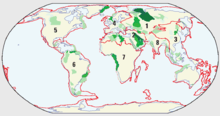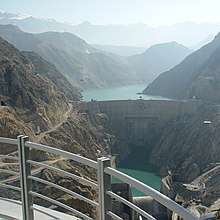Energy in Iran
Iran has the fourth largest oil reserves and the largest natural gas reserves in the world,[1][2] and is considered an energy superpower.[3]


History
Iran is in a constant battle to use its energy resources more effectively in the face of subsidization and the need for technological advances in energy exploration and production. Energy wastage in Iran amounts to six or seven billion dollars (2008). The energy consumption in the country is extraordinarily higher than international standards. Iran recycles 28 percent of its used oil and gas whereas the figure for certain countries stands at 60 percent.[4] Iran paid $84 billion in subsidies for oil, gas and electricity in 2008.[5] Iran is one of the most energy-intensive countries of the world, with per capita energy consumption 15 times that of Japan and 10 times that of European Union. Also due to huge energy subsidies, Iran is one of the most energy inefficient countries of the world, with the energy intensity three times higher than global average and 2.5 times the middle eastern average.[6] Half of the country’s energy is wasted in domestic sector, 3.4 of which is wasted through single-occupancy vehicle use and 2/3 parts of power plants' energy are also wasted.[7]
Iran is one of the leading members of OPEC (Organization of Petroleum Exporting Countries) and the Organization of Gas Exporting Countries (GECF). Iran received $47 billion in oil export revenues, which accounts for about 50% of state revenues.[8] Natural gas and oil consumption both account for about half of Iran’s domestic energy consumption. With its heavy dependence on oil and gas revenues Iran continues to explore for new sources of natural gas and oil. Recently Iran has focused its energy sector on the exploration of the South Pars offshore natural gas fields in the Persian Gulf.[9]
Iran has become self-sufficient in designing, building and operating dams and power plants and it has won a good number of international bids in competition with foreign firms.[10][11]
Energy generation capacity of Iranian thermal power plants reached 173 terawatt hours in 2007, accounting for 17.9 percent of energy production in the Middle East and African region. Natural gas has been the main energy in Iran in 2007, comprising over 55 percent of energy needs, while oil and hydroelectricity accounted for 42 and 2 percent respectively. The region’s energy need will increase by 26.8 percent until 2012.[12] In 2017, the fuel consumption in Iran was equivalent to 5.5 million barrels of fuel per day (bpd), the rate of which is considered as the highest energy consumption rate in the world in terms of energy intensity.[13]
Energy plays an important role in Iranian politics. Robert Baer in his book The Devil We Know: Dealing with the New Iranian Superpower argues that Iran has attained the status of an energy superpower and is on its way to become a military-political superpower.[14]
Overview
Iran plans to create an energy saving company in conjunction with the Iranian subsidy reform plan (2014).[15]
| Population (million) |
Prim. energy (TWh) |
Production (TWh) |
Export (TWh) |
Electricity (TWh) |
CO2-emission (Mt) | |
|---|---|---|---|---|---|---|
| 2004 | 67.0 | 1,696 | 3,233 | 1,530 | 137 | 369 |
| 2007 | 71.0 | 2,151 | 3,757 | 1,602 | 165 | 466 |
| 2008 | 72.0 | 2,350 | 3,801 | 1,429 | 174 | 505 |
| 2009 | 72.9 | 2,514 | 4,068 | 1,537 | 168 | 533 |
| 2010 | 73.97 | 2,423 | 4,060 | 1,574 | 196 | 509 |
| 2012 | 74.80 | 2,467 | 4,113 | 1,614 | 200 | 521 |
| 2012R | 76.42 | 2,554 | 3,523 | 961 | 210 | 532 |
| 2013 | 77.45 | 2,656 | 3,477 | 649 | 224 | 526 |
| Change 2004-10 | 10.4% | 42.9% | 25.6% | 2.9% | 43.0% | 37.8% |
| Mtoe = 11.63 TWh, Prim. energy includes energy losses
2012R = CO2 calculation criteria changed, numbers updated | ||||||
Primal energy demand
- gas: 55% (2008)[17]
- oil: 42% (2008)
- hydro: 2% (2008)
Primary energy sources
Oil
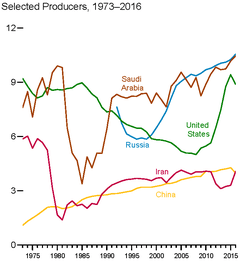
(million barrels per day)
Iran has the second largest oil reserves in the world, and the third largest exporter of it. According to 2006 estimates Iran produced about five percent of total global crude oil production. They produced 4.2 million barrels per day (670,000 m3/d) of total liquids and 3.8 million of those barrels were crude oil. Iran plans to invest $100 billion during the next four years in different sections of its oil industry (2009).[18] By the end of 2009, Iranian oil R/P ratio was 89.4 years which is the world's highest.[19] By 2009, Iran had 52 active rigs and 1,853 producing oil wells.[20]
Iran possesses abundant fuels from which to generate energy. Since 1913 Iran has been a major oil-exporting country. Oil industry output averaged 4 million barrels (640,000 m3) per day in 2005, compared with the peak output of 6 million barrels per day (950,000 m3/d) reached in 1974. Following the 1979 revolution, however, the government reduced daily oil production in accordance with an oil conservation policy. Further production declines occurred as result of damage to oil facilities during the war with Iraq. In the early 2000s, industry infrastructure was increasingly inefficient because of technological lags. Few exploratory wells were drilled in 2005. Iranian oil was nationalized in 1953 and thus is owned and operated by the National Iranian Oil Company (NIOC).
Iran held 10.3% of the world's total proven oil reserves and that figures out to be about 137.6 billion barrels (2.188×1010 m3) of oil reserves at the end of 2009.[19] Oil also is found in northern Iran and in the offshore waters of the Persian Gulf. Nevertheless, in 2005 Iran spent US$4 billion on gasoline imports, mainly because of contraband and inefficient domestic use that result from subsidies. Iran is one of the largest gasoline consumers in the world ranking second behind United States in consumption per car.[21]
There is a growing recognition that prices must rise faster to curb consumption and ease the burden on the public finances. Cheap energy has encouraged wasteful consumption in Iran, and a brisk business in smuggling petrol into Iraq, Turkey, Pakistan and Afghanistan. Demand has also been supported by rapid increases in car production in recent years. In the absence of imports, the car industry has developed strongly (albeit from a low base) with output reaching over 1m vehicles in fiscal year 2006/07 (March 21 – March 20).[22]
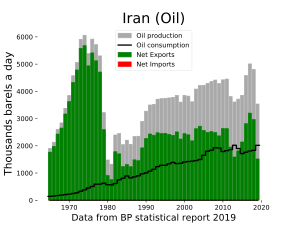
The growth in consumption of domestically produced oil has been modest, owing to refining constraints. By contrast, fuel imports rose to 180,000 barrels per day (29,000 m3/d) in January 2005 from 30,000 barrels per day (4,800 m3/d) in 2000, and petrol consumption is estimated to have been around 1,800,000 barrels per day (290,000 m3/d) in 2007 (before rationing), of which about one-third is imported. These imports are proving expensive, costing the government about US$4bn in the first nine months of 2007/08, according to parliamentary sources.[22] Nearly 40% of refined oil consumed by Iran is imported from India.[23]
Iran contains 27 onshore and 13 offshore oil-producing fields, largely concentrated in the southwestern Khuzestan region near the Iraqi border.[9] The Iranian government is heavily reliant on oil revenues and they have heavily subsidized the energy industries, which figures out to be about 12% of Iran’s GDP. However, domestic oil consumption has decreased due to the alternative use of natural gas. Economic growth from these resources is uncertain and stunted in Iran due to these subsidies and population growth. Iran has been unable to reach it full production levels due to a combination of sanctions and war plaguing the region. Iran’s oil fields have a natural decline rate at 8 percent for onshore wells and 10% for offshore fields. The Iranian recovery rate is currently approximately 27 percent, which is well below the world average. Iran needs structural improvements made to coincide with their enhanced oil recovery efforts.[9]
Oil:[24]
- production: 3,589,000 bbl/d (570,600 m3/d) (2012 est.)[25]
- consumption: 1,755,000 bbl/d (279,000 m3/d) (2008 est.) (expected to increase 10% each year since 2006)
- exports: 2,377,000 bbl/d (377,900 m3/d) (2010 est.)
- imports: 156,000 bbl/d (24,800 m3/d) (2010 est.)
- proved reserves: 154.6 Gbbl (24.58×109 m3) based on Iranian claims (1 January 2009 est.)
note: as of 2009, 1/3 of Iran's gasoline needs are imported because of insufficient domestic refining capacity, over-consumption and contraband.[26]
Natural gas
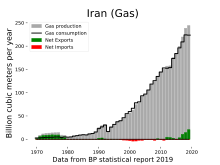
Iran is the world's third producer of natural gas (5.1% of the world's total and 184 BCM); which is primarily used for domestic electricity generation or heat production.[27] It contains an estimated 1,187.3 trillion cubic feet (33,620 km3) (Tcf) in proven natural gas reserves.[2] In 2005 a large share of Iran’s natural gas reserves were believed to remain untapped. About 62% of these reserves are located in non-associated fields. Iranian production of natural gas is expected to increase over the next few years due to continuing discoveries in the North Pars and South Pars regions.[28]
Domestic consumption has matched production at 3.6×1012 cu ft (100 km3) in the year of 2005. Domestic consumption is expected to go up at about 7% per year for the following decade. The Iranian government has also subsidized natural gas prices along with gasoline prices, and this is expected to sustain this high level of domestic consumption. In lieu of this increasing domestic demand, natural gas exports are expected to decrease in the following years.[29]
Iran has the third largest consumption of natural gas in the world after United States and Russia.[30] Iran also has the world's largest growth rate in natural gas consumption.[19]
Natural gas:[24]
- production: 151.8 billion cu m (2011 est.)
- consumption: 144.6 billion cu m (2010 est.)
- exports: 9.05 billion cu m (2011 est.)
- imports: 10.59 billion cu m (2011 est.)
- proved reserves: 33.61 trillion cu m (1 January 2013 est.)
Nuclear energy
Iran plans to generate 23,000 MW of electricity through nuclear technology to meet its increasing demand for energy.[31] The first of four 915 MW reactors of Bushehr Nuclear Power Plant, built with help from Russia, came online in August 2010[32] after numerous delays and Iran's indigenously designed Darkhovin Nuclear Power Plant is scheduled to come online in 2016. Overall, Iran remains a net exporter of electricity and exchanges electrical power with all its land neighbors.[33] While nuclear power in the US costs a little over 10 cents per kilowatt hour, Iran, with domestic uranium enrichment capabilities, high interest rates, low energy output (a single 1,000-watt reactor), low efficiency, extremely slow reactor construction, and no reprocessing pays around 68 cents per kilowatt hour (this assumes a price of $140 per separative working unit and of $40 per kilogram of uranium).[34]
Hydro
Hydropower makes up 10,000 megawatts or 14% of Iran’s overall energy mix (2015).[35] Iran is able to build its water turbines domestically.[35]
Biofuel
In 2016, the Iranian Biofuel Society (IBS) in collaboration with the Vice Presidency for Science of Technology and Tehran and the Suburbs Bus Company executed the first urban pilot project for the consumption of waste cooking oil biodiesel in Tehran`s bus fleet in an attempt to generate public awareness regarding Global Climate Change, wherein they recommend “reducing net anthropogenic CO2 emissions to the atmosphere” and “minimizing anthropogenic disturbances of” atmospheric gasses by partial replacement of fossil fuels with waste-oriented biofuels.[36] The program was also supported by Small Grant Programme, Global Environmental Facility, United Nation Development Program (SGP/GEF/UNDP) Office in Iran.[37]
Solar
Iran's unique geographical position means 90% of the country has enough sun to generate solar power 300 days a year. According to PressTV Iran has 520 watts per hour per square meter of solar radiation every day.[38] Other sources give an average of 2,200 kilowatt-hour solar radiation per square meter annually.[39] Solar power reached 53 MW in 2005 and 67 MW in 2011.[38]
Wind
Iran has the potential to generate 20 to 30 GW of wind energy. That is half of the total energy consumption needs of the country. As at 2012 Iran had 163 wind turbines with an installed capacity of 92,470 kW.[38] Sadid Industrial Group is a well known domestic manufacturer in this field. India's Sulzon Energy and Germany's Siemens are also potential providers of wind turbines to Iran.[35]
Geothermal
Iran has the potential to become the 9th largest geothermal energy producer.[38] According to global tectonics Iran is impacted by subduction of the Arabian Plate under the Central Iranian Plate and four thrust faults: two that make the Southern Caspian Sea Depression and two in the north of Iran, part of the Caucasian Range. Mt. Sabalan and Mt. Sahand are two Quaternary Volcanos in the area. Sabalan is a large stratovolcano consisting of 3 summits named Soltan (4811), Heram (4612m) and Kasra (4573m). The stratovolcano is situated on a possible horst trending northeast-southwest and erupted at latest in the Holocene. Caldera collapsing has caused a depression about 400 m in height and 12 km in diameter. The lava flows consists of trachyandesite, andesite and dacite and pyroclastic deposits. There are 9 hot springs with a temperature in the range of 25-85 °C.[40]
Electricity
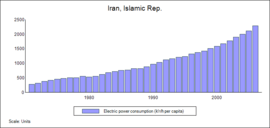
Electricity generation by fuel in Iran - 2012[43]
Iran’s domestic consumption and production have steadily grown together since 1984 and it is still heavily reliant on traditional thermal energy sources of electricity, with a small fraction being produced by hydroelectric plants.[44] Consumption has steadily risen and it is expected to rise at about 6 percent per year for the following decade. Accordingly, the Iranian energy sector must focus its efforts on meeting this continuing demand. Today Iran ranks 19th largest producer and 20th largest consumer of electricity in the world.[45] A research by the Ministry of Energy indicated that between 15,000-20,000 megawatts of capacity should be added in Iran in the next 20 years.[46] In recent years Iran has put greater emphasis on participation of domestic and foreign investors in electricity generation sector, with projects underway to add 40,000 MWh more capacity to the national grid.[47]
It is estimated that some 18.5 percent of electricity generated in Iran are wasted before it reaches consumers due to technical problems.[48] Iran is among the top ten manufacturers of gas turbines with a capacity of 160 megawatts.[49] Iranian experts of JEMCO (a subsidiary of IDRO) have succeeded in developing the capacity to produce one-megawatt generators.[50] Iran has acquired self-sufficiency of over 80 percent in constructing hydraulic turbines and over 90 percent in producing gas turbines. Within the next few years, Iran can join the list of countries that produce power plant technology (2009).[51] Iran has achieved the technical expertise to set up hydroelectric, gas and combined cycle power plants.[52] Iran is not only self-sufficient in power plant construction but has also concluded a number of contracts on implementing projects in neighboring states.[53][54]
The exploration efforts for sources of power generation are wide and diverse in Iran. Plans are being made to make oil efficient power plants as well as an emphasis on natural gas production in order to meet their growing electricity demand. Nuclear power and hydroelectric power are not focused on for the time being, but they are part of an overall strategy to meet electricity demands. The electricity sector is also heavily subsidized and mostly state owned companies control power distribution, transmission and generation. In order to meet the demands of the electricity sector, however, Iran is beginning to look into private investment.[55] A by-law has been passed allowing the energy ministry to conclude rial or combined rial/foreign-currency contracts for the purchase of electricity from private companies.[22] Private companies in Iran generated 14,440 megawatts of electricity in 2009.[56]
Although some criticize Iran's hydroelectric power plans as potentially dangerous to the environment, most agree that the country's current state of hydroelectric production is much better off than in the past. Iran has displayed a new approach to this sector. After the 1979 Islamic Revolution, the construction of hydroelectric power plants became both a popular private and public venture. Often, construction projects did not meet basic environmental standards, engineering standards, and technical requirements. As a result, many of these dams were destroyed or left in dilapidated conditions.[57]
By 2004, the addition of new hydroelectric stations and the streamlining of conventional coal- and oil-fired stations increased installed capacity to 33,000 megawatts (MW). Of that amount, about 75 percent was based on natural gas, 18 percent on oil, and 7 percent on hydroelectric power. However, in 2004 Iran opened its first wind-powered and geothermal plants, and the first solar thermal plant was to come online in 2009. Iran has recoverable coal reserves of nearly 1.9bn short tonnes. The country produces about 1.3m short tonnes of coal annually and consumes about 1.5m short tonnes, making it a small net importer of coal.[22]
Demographic trends and intensified industrialization have caused electric power demand to grow by 8 percent per year. The government’s goal of 53,000 megawatts of installed capacity by 2010 is to be reached by bringing on line new gas-fired plants financed by independent power producers, including those with foreign investment backing, and by adding hydroelectric and nuclear power generating capacity. It has also been estimated that Iran has the potential to produce at least 6,150 MWh of electricity by Wave power from its coastline on Persian Gulf alone.[58] Iran is also experimenting with electricity generation from organic wastes and plans to build power plants using sewage and organic waste of domestic and industrial origin as fuel.[59] Another area in which there is ongoing research is assessment of Iran's tidal power potential.[60] With about 300 clear sunny days a year and an average of 2,200 kilowatt-hour solar radiation per square meter, Iran has a great potential to tap solar energy.[61]
Electricity:
- production: 220.3 billion kWh (2011 est.)[62]
- consumption: 182.7 billion kWh (2010 est.)[24]
- exports: 6.707 billion kWh (2010 est.)[24]
- imports: 3.015 billion kWh (2010 est.)[24]
Electricity production by source:
Energy forecast
| Source: B.M.I[63] | 2010 | 2015 est. | 2010-15 growth | 2015-20 growth | 2010-20 growth | Remarks |
|---|---|---|---|---|---|---|
| MENA-Power generation | 1,222 TWh | 1,518 TWh | +24.2% | N/A | N/A | where markets were depressed by the economic slowdown in 2009. |
| MENA-Thermal power generation | 1.140 TWh (93.3% of total electricity supplied in the region) | 1,378 TWh (90.8% of total electricity supplied in the region) | N/A | N/A | N/A | thanks in part to environmental concerns that should be promoting renewables, hydro-electricity and nuclear generation. |
| MENA-Energy demand | N/A | 1117 tonnes of oil equivalent (toe) | +20.8% | N/A | N/A | N/A |
| MENA-Nuclear demand | N/A | ~25 TWh | N/A | N/A | N/A | N/A |
| IRAN-Real GDP growth | N/A | N/A | 2% per year (average) | N/A | N/A | N/A |
| IRAN-Population | 73.9 million | 78.6 million | N/A | N/A | N/A | N/A |
| IRAN-GDP per capita growth | N/A | N/A | +31% | N/A | N/A | N/A |
| IRAN-Electricity consumption per capita | N/A | N/A | +5% | N/A | N/A | N/A |
| IRAN-Power consumption | 161 TWh | 179 TWh | 2.2% per year (average) | N/A | N/A | a broadly balanced market |
| IRAN-Electricity generation | N/A | N/A | +12.2% | +11.9% | +25.5% | N/A |
| IRAN-Thermal generation | 192 TWh (16.85% of MENA's market share) | (14.45% of MENA's market share) | N/A | N/A | N/A | N/A |
| IRAN-Primary Energy Demand (PED) & Growth | 37.8% (gas), 40.4% (oil), 0.8% (hydro) | N/A | +14.4% | +12.6% | +28.8% | N/A |
| IRAN-Energy demand | 22.38% (Iran's MENA market share) | 21.21% (Iran's MENA market share) | N/A | N/A | N/A | N/A |
| IRAN-Nuclear demand | 0 | 10 TWh (38.46% of MENA's market share) | N/A | N/A | N/A | Bushehr Nuclear Power Plant set to go online in 2011. Nuclear power is one key element of generation growth. |
Subsidies
Iran was estimated to have paid $84 billion for oil, gas and electricity subsidies in 2008.[64]
Iran is the world largest energy subsidizer, leading to highly wasteful consumption patterns, price distortions in its economy, pollution and very lucrative contraband with neighboring countries because of price differentials.
Environment
Renewable energy
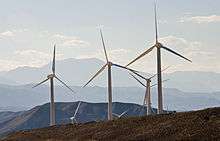
In 2010, the Iranian government announced plans to build 2,000 MW of renewable energy capacity between 2010-2015. As of 2010, Iran had 8,500 MW of hydroelectric capacity and 130 MW of wind energy capacity. As at 2010, private companies had signed contracts to build more than 600 MW of biomass systems and 500 MW of new wind energy projects.[65]
Iran is also working to make renewable energy commercially viable and the Ministry of Energy is required to buy privately produced renewable energy at world market prices. A feed-in-tariff (FiT) for wind and biomass energy around 13 cents/kWh is helpful.[65]
In 2012, Iran allocated €500 million from the National Development Fund for renewable energy projects. Also supporting the solar industry is the state-sponsored Renewable Energy Organization of Iran (SUNA), which is attached to the Energy Ministry and enjoys a budget of around $60 million.[65]
See also
- Economy of Iran
- Energy development
- International rankings of Iran
- Ministry of Energy (Iran)
- Oil megaprojects (2011)
- Wind power in Iran
- Nationalization of the Iranian oil industry
- List of renewable energy topics by country
References
- "CIA - The World Factbook". Cia.gov. Archived from the original on 2012-10-20. Retrieved 2012-02-05.
- "Archived copy" (PDF). Archived from the original (PDF) on 2013-08-14. Retrieved 2013-06-23.CS1 maint: archived copy as title (link)
- Energy and the Iranian economy. United States Congress. July 25, 2006. ISBN 9781422320945. Retrieved June 11, 2014.
- "Energy Wastage In Iran Equals 6-7 Billion Dallars Per Year". Payvand.com. Retrieved 2012-02-05.
- https://web.archive.org/web/20080612142508/http://www.iran-daily.com/1387/3111/html/economy.htm. Archived from the original on June 12, 2008. Retrieved June 18, 2008. Missing or empty
|title=(help) - Taghizadeh, Reza (2010-06-10). "Sanctions And Iran's Achilles Heel". Rferl.org. Retrieved 2012-02-05.
- http://en.mehrnews.com/detail/News/102219
- BBC News, “Iran Energy: Overview”, http://news.bbc.co.uk/1/hi/world/middle_east/4688984.stm, April 1, 2008.
- EIA, “Iran’s Energy Data”, "Archived copy". Archived from the original on 2009-04-02. Retrieved 2012-04-07.CS1 maint: archived copy as title (link), April 1, 2008.
- "Iran to build power plants in Ecuador". Payvand.com. Retrieved 2012-02-05.
- https://web.archive.org/web/20081204232447/http://www.iran-daily.com/1387/3280/html/economy.htm. Archived from the original on December 4, 2008. Retrieved November 26, 2008. Missing or empty
|title=(help) - PWKD. "Petrol World - Iran: Mobile App For Online Fuel Purchase Launch". www.petrolworld.com. Retrieved 2019-02-28.
- Robert Baer (2008). The Devil We Know: Dealing with the New Iranian Superpower. Crown Publishers. ISBN 978-0-307-40864-8.
- "دسترسی غیر مجاز".
- IEA Key World Energy Statistics Statistics 2015, 2014 (2012R as in November 2015 + 2012 as in March 2014 is comparable to previous years statistical calculation criteria, 2013 Archived 2014-09-02 at the Wayback Machine, 2012 Archived 2013-03-09 at the Wayback Machine, 2011 Archived 2011-10-27 at the Wayback Machine, 2010 Archived 2010-10-11 at the Wayback Machine, 2009 Archived 2013-10-07 at the Wayback Machine, 2006 Archived 2009-10-12 at the Wayback Machine IEA October, crude oil p.11, coal p. 13 gas p. 15
- https://web.archive.org/web/20091001021913/http://www.iran-daily.com/1387/3323/html/economy.htm. Archived from the original on October 1, 2009. Retrieved February 19, 2016. Missing or empty
|title=(help) - PressTV:Iran invests $100b in oil industry in 4 years Archived 2009-06-30 at the Wayback Machine Retrieved July 14, 2009
- "BP Statistical Review of World Energy" (PDF). Archived from the original (PDF) on 2013-08-25. Retrieved 2012-02-05.
- http://www.opec.org/opec_web/static_files_project/media/downloads/publications/ASB2009.pdf
- "Green Party of Iran - News". Iran-e-sabz.org. Retrieved 2012-02-05.
- "Iran at a glance" (PDF), Development Economics, Development Data Group (DECDG)., World Bank, 27 March 2009, retrieved 2009-07-12
- Does US road to better relations with Iran pass through India?, The Christian Science Monitor, July 18, 2009
- CIA factbook
- "CIA - The World Factbook - Iran". Cia.gov. Archived from the original on 2012-02-03. Retrieved 2012-02-05.
- "Iran Energy Data, Statistics and Analysis - Oil, Gas, Electricity, Coal". Eia.doe.gov. Archived from the original on 2008-03-31. Retrieved 2012-02-05.
- https://www.iea.org/publications/freepublications/publication/KeyWorld2016.pdf
- National Iranian Gas Company
- EIA, Iran’s Energy Data Archived 2009-04-02 at the Wayback Machine, April 1, 2008
- "CIA - The World Factbook". Cia.gov. Archived from the original on 2012-10-09. Retrieved 2012-02-05.
- "Iran and Nuclear Energy". Irvl.net. Archived from the original on 2010-12-15. Retrieved 2012-02-05.
- PRIS.Contact-Point@iaea.org. "Power Reactor Details - BUSHEHR 1". Iaea.org. Archived from the original on 2010-08-26. Retrieved 2012-02-05.
- "PressTV - Iran exports 5.5 bn kWh of electricity". Presstv.ir. 2010-09-06. Retrieved 2012-02-05.
- "Iran's nuclear program may have cost the country $500 billion or more". July 2015.
- "Iran joins water turbine manufacturers club".
- "تفاهم نامه استفاده از سوخت های زیستی در اتوبوسرانی تهران امضا شد".
- "UNDP-GEF Small Grant Programme".
- http://presstv.com/Program/251519.html
- "Solar Power Plants To Replace Fossil Fuel". Zawya. 2010-12-20. Archived from the original on 2011-06-10. Retrieved 2012-02-07.
- https://www.geothermal-energy.org/pdf/IGAstandard/WGC/2005/0607.pdf
- Iran daily:Energy Wastage Criticized Retrieved April 15, 2009
- Iran Daily - Domestic Economy - 02/01/07 Archived September 30, 2007, at the Wayback Machine
- "International - U.S. Energy Information Administration (EIA)".
- retrieved April 2, 2008. Archived October 12, 2008, at the Wayback Machine
- "CIA - The World Factbook". Cia.gov. Archived from the original on 2012-02-03. Retrieved 2012-02-05.
- Iran Daily - National - 04/11/07 Archived September 30, 2007, at the Wayback Machine
- http://www.iran-daily.com/1388/3374/html/economy.htm. Retrieved April 15, 2009. Missing or empty
|title=(help) - https://web.archive.org/web/20090521090141/http://www.iran-daily.com/1388/3402/html/economy.htm. Archived from the original on May 21, 2009. Retrieved May 24, 2009. Missing or empty
|title=(help) - "No Operation". Presstv.com. Archived from the original on 2012-06-06. Retrieved 2012-02-05.
- https://web.archive.org/web/20090819023142/http://www.iran-daily.com/1388/3473/html/economy.htm. Archived from the original on August 19, 2009. Retrieved August 16, 2009. Missing or empty
|title=(help) - "No Operation". Presstv.com. Archived from the original on 2012-05-15. Retrieved 2012-02-05.
- "No Operation". Presstv.com. Archived from the original on 2012-06-06. Retrieved 2012-02-05.
- Iran-Daily:Hydroelectric Power Generation Will Increase Archived October 12, 2008, at the Wayback Machine
- EIA, “Iran’s Energy Data”, "Archived copy". Archived from the original on 2009-04-02. Retrieved 2012-04-07.CS1 maint: archived copy as title (link), Retrieved April 2, 2008
- "No Operation". Presstv.com. Archived from the original on 2012-05-27. Retrieved 2012-02-05.
- International Journal of Water Resources Development; Mar2002, Vol. 18 Issue 1, p179-182, 4p
- "Study on feasibility of establishing a wave power-plant in Persian Gulf". Civilica.com. Retrieved 2012-02-05.
- Suna. "مطالعه امکان سنجی و طراحی مفهومی نیروگاه بیوگاز ساوه سازمان انرژی های نو ایران". Suna.org.ir. Archived from the original on 2012-03-05. Retrieved 2012-02-05.
- "Study and calculation of extractable tidal power in south coastal zones of Iran". 08. Civilica.com. 2006-03-11. Retrieved 2012-02-05. Cite journal requires
|journal=(help) - "Solar Power Plants To Replace Fossil Fuel". Zawya. 2010-12-20. Retrieved 2012-02-05.
- https://web.archive.org/web/20100612004113/http://iranyellowpages.net/en/about_iran/Economy/electricity_industry/electricity_industry01.shtm
- "Iran to Account for 14.79% of MEA Power Generation by 2015: BMI". Payvand.com. Retrieved 2012-02-05.
- Iran Daily - Domestic Economy - 04/27/08 Archived June 12, 2008, at the Wayback Machine
- "Invest in Iran's renewable energy? Not so crazy". Christian Science Monitor. 2012-09-10.
External links
| Wikimedia Commons has media related to Energy in Iran. |
- (in English) Ministry of Energy Of Iran - Official Website
- (in English) Renewable Energy & Energy Efficiency Organization Of Iran - Official Website
- (in English) Ministry of Economic Affairs and Finance Of Iran - Official Website
- (in English) Ministry of Industry , Mine & Trade Of Iran – Official Website
- Iran Energy Profile - International Energy Agency
- Annual Reviews - Reports by the Central Bank of Iran, including statistics about the energy sector in Iran.
- US Department of Energy - Iran
- Brief Sector & Environment Study (2003)
- Energy Security Implications of an Iran in Transition
- Tavanir - Iran's Electric Power Generation Organization
- Ahmadinejad's Gas Revolution: A Plan to Defeat Economic Sanctions
- IAEA: Energy and electricity in Iran (2002)
- Solar insolation maps
- Videos
- Renewable Energy in Iran - PressTV (2012)
- Iran's energy bourse - PressTV (2012)
